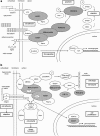Cerebral cavernous malformations: from molecular pathogenesis to genetic counselling and clinical management
- PMID: 21829231
- PMCID: PMC3260921
- DOI: 10.1038/ejhg.2011.155
Cerebral cavernous malformations: from molecular pathogenesis to genetic counselling and clinical management
Abstract
Cerebral cavernous (or capillary-venous) malformations (CCM) have a prevalence of about 0.1-0.5% in the general population. Genes mutated in CCM encode proteins that modulate junction formation between vascular endothelial cells. Mutations lead to the development of abnormal vascular structures.In this article, we review the clinical features, molecular and genetic basis of the disease, and management.
Figures



References
-
- Labauge P, Denier C, Bergametti F, et al. Genetics of cavernous angiomas. Lancet Neurol. 2007;6:237–244. - PubMed
-
- Dashti SR, Hoffer A, Hu YC, et al. Molecular genetics of familial cerebral cavernous malformations. Neurosurg Focus. 2006;21:e2. - PubMed
-
- Rigamonti D, Hadley MN, Drayer BP, et al. Cerebral cavernous malformations. Incidence and familial occurrence. N Engl J Med. 1988;319:343–347. - PubMed
Publication types
MeSH terms
LinkOut - more resources
Full Text Sources
Other Literature Sources
Medical

